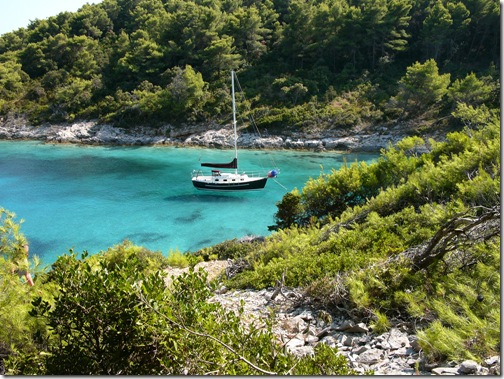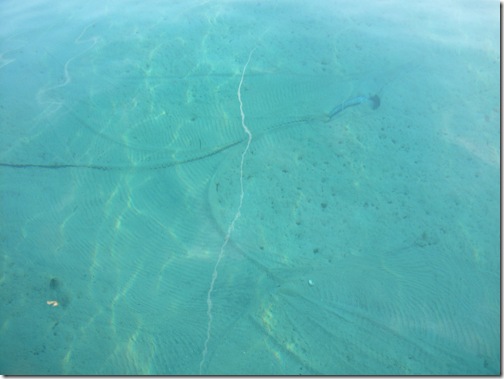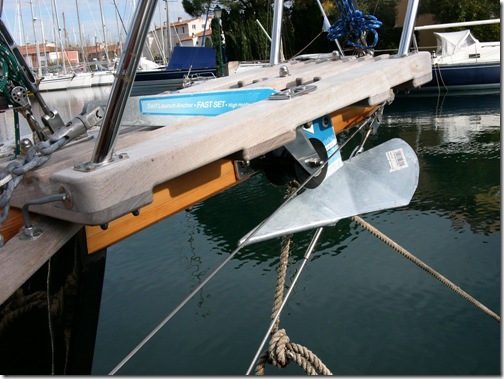Leica Digilux 2, Doolittle in the ‘Blue Lagoon’ Croatia.
Like most things these days, anchors are being constantly developed and are now more effective and easier to use. There is a bewildering choice of anchors out there made in alloy, steel or stainless. No one to my knowledge has yet made a plastic anchor but that’s probably because a bit of weight doesn’t hurt. Maybe it’s a throwback from the old days when the weight of the anchor played a big part in mooring your boat to the sea bed. Today anchors are designed to be dug in so being heavy is no longer so important.
So why did I choose the Delta over all the others? Well mainly because I only ever heard good things said about it and because it is designed to work with a rope rode with just a short amount of chain. Since I believe in the KISS philosophy aboard my boat I like the idea of using rope and not chain. Chain is heavy, noisy and goes rusty. It’s not nice to haul up by hand either. Most people these days buy a windlass but if you only have a small anchor it’s hardly necessary. Rope is also stretchy and quiet.
One of the great things about sailing in the Med is that you can clearly see when your anchor is dug in just by looking over the side!
The instructions for the Delta call for a couple of metres of chain and the rest rope. It seems hardly creditable that so short a piece of chain would be enough to ensure the efficiency of the anchor but there you are. I chose a 22lb (10kilo) Delta which is for boats up to 40 feet long. I don’t understand why anchors are rated by boat length and not weight so just to be sure I went for the next size up as my boat might only be 24 feet long but it weighs 5 tons. Also we anchor a lot so an anchor that we can trust is essential for a good nights sleep.
I also used 10mm chain instead of the recommended 6mm and made it 5 metres long. Then I attached 20mm dia three strand nylon rope. It’s a good diameter to grip and very strong.
The first issue I had was that the anchor would not stow on the bow platform which was originally designed for a CQR with it’s articulated head. The Delta is more or less the same shape but is in one piece . The problem was that the flukes would touch the bottom of the bowsprit before it could be stowed correctly. On most boats with a simple bow, the Delta would fit beautifully. Making the Delta fit on a Pacific Seacraft Dana called for a bit of imagination and some creative metalwork.
Once that was solved we went out to anchor to try it. There was 20 knots of wind blowing when we dropped the hook and the wind caught the boat’s high bows and she swung off downwind before I could get the anchor away. I dropped the anchor and paid out a decent amount of scope then as soon as the anchor touched the bottom it dug in and the rope was almost wrenched out of my hands. I quickly put a turn on a cleat. The boat swung quickly into the wind and stopped with a force that nearly had me off my feet. I was impressed.
This was no fluke (no pun intended) as every time I anchored the anchor would bite straight away. It works best in sand and mud but doesn’t seem to mind weed either. Once it’s dug in, it’s possible to reduce the scope massively which is helpful in a crowded anchorage. Getting the Delta anchor out can sometimes be quite hard, so well does it dig in. After a few days at anchor you can longer see the anchor at all, only the chain is visible.
There have been times when I have struggled to get the anchor undug. I find that it pays to pull the rope as much as you can so that it is ‘up and down’ then put a turn around a cleat and wait for the buoyancy of the boat as it bobs to gradually pull it out inch by inch. It can take a few minutes. If this doesn’t work I could always tug it out by motoring over it but that might damage my gelcoat. If I am patient it always comes out in the end.
However it’s very reassuring to know that the anchor is hard to get out. The anchor has been severely tested a number of times but the most dramatic was in Sicily after we had sailed through the Messina Straits in a gale and decided to ride it out in the lee of the land. We remained at anchor for 24 hours while the hot wind blew at a steady 40 knots. It was like standing in front of a gigantic fan heater. The rope was stretched bar tight and the pull on it was incredible yet we were quite safe.
In my opinion, the Delta anchor is the best of the lot. It works in almost all seabeds, is solid and well made and not that expensive compared to some. I have done a lot of anchoring in 20 years in many different boats and on different bottoms and the Delta is the most consistent. It always works. I did not have much success with a CQR but I have heard this from others in the Med. They don’t like weed and there’s a lot of it in the Med.
Our kedge anchor is a Fortress. It’s extremely light (6kilos) but is very strong and works extremely well. It used to be our main anchor on the last boat and I might have used it on the Dana too but it doesn’t stow well. It’s light weight makes it easy to stow in a locker and retrieve it when needed and because it’s not made of steel it doesn’t leave rust stains all over the place. The Delta is heavily galvanised and even after 5 years of heavy use, only the tip is looking slightly worn.
So if you are looking for a great anchor that you can trust get a Delta.


